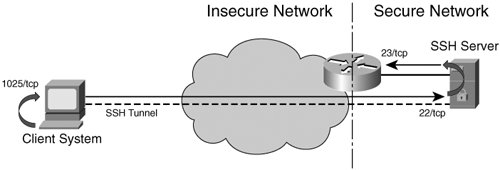Management Access
| Control of access to the management interface of network infrastructure devices is critical. Network devices such as routers, switches, intrusion detection sensors, and firewalls should be accessed only by those users who need to administer them. This requirement stems from the fact that an unauthorized user, whether someone with malicious intent or not, may change the configuration or disable the device and thus lower the security of the surrounding network. Management access comes in two forms: in-band and out-of-band. Additional considerations must be made regarding how the firewall is accessed: Telnet, SSH, SNMP, FTP, TFTP, HTTP/HTTPS, or some proprietary management protocol and must conform to the management access policy as discussed in Chapter 10, "Firewall Security Policies." In-Band ManagementIn-band management refers to the administrative access to systems and network devices over the same network that is used by the traffic being filtered. In-band management can represent a significant risk to the administrator if certain precautions are not taken. These risks center predominantly around the use of unencrypted communications channels. Specific attention must be paid to the use of encrypted communications such as SSH and HTTPS when considering whether to manage a firewall in-band. The use of simple Telnet or HTTP can result in the administrative password being captured by an attacker who is sniffing the traffic between the administrative interface of the firewall and the rest of the network. In-band management also runs the risk of being susceptible to a denial-of-service (DoS) attack during large-scale outbreaks such as worms. This would make it more difficult to reconfigure the firewall during such an event to block traffic or shut it off altogether if necessary to defeat the attack. Out-of-Band ManagementAs the term indicates, out-of-band management results in access to the firewall through a secondary channel that is not carrying production traffic. This can either be a VLAN setup for administrative access to network devices and hosts or, preferably, a completely separate physical network. In addition, out-of-band management can be used to provide access to the serial port of the network device for access should the network fail. Out-of-band management can be more time-consuming to set up and not cost effective for smaller networks, but it represents the most secure and reliable method of administering firewalls and other network equipment. Telnet vs. SSHTelnet is an unencrypted network communication protocol that is typically used to provide remote access to systems and other devices. Telnet is originally defined in RFC 854 and was developed long before the Internet was in its current formwhen networks were much smaller. Not much consideration was given in the Telnet protocol design to confidentiality in the data being transmitted using the protocol. Therefore, all data transmitted using the Telnet protocol is subject to eavesdropping and susceptible to capture. SSH provides for cryptographic protection of data as well as authentication and ensures that the integrity and confidentiality of the communication is secured. If a device can support SSH as an access method to the command line, it should be preferred over Telnet. Alternatively, if the device's GUI is accessible within a secure network and it is necessary to remotely manage the device across an insecure network and an SSH connection can be established, it is possible to tunnel the connection through SSH. To establish an SSH tunnel between two hosts, you need to use port forwarding. In the example shown in Figure 11-6 the client establishes an SSH connection through to the SSH server on TCP port 22 (the standard SSH port). However, the client uses the port-forwarding capability to forward his localhost TCP port 1025 and redirects it to the Telnet port of on the router. To access the Telnet port of the router through the tunnel, the client need only telnet to his localhost TCP port 1025 and he will automatically be redirected, through the SSH tunnel, to the router's Telnet port. Figure 11-6. SSH Forwarding Across an Insecure Network This way the traffic goes through an encrypted SSH session between the client and the SSH server and then the traffic can be forwarded using an insecure protocol such as Telnet. HTTP vs. HTTPSA discussion about the use of HTTP versus HTTPS follows a similar line of thought as the previous discussion about Telnet versus secure shell. HTTP is an unencrypted protocol that allows eavesdroppers to view the communication between the client and the server. Although attackers may not necessarily be able to capture the password to the web server, they may be able to capture other information such as specific configuration information or possibly a valid cookie that would then allow the attacker to impersonate a legitimate user and gain access to the firewall's administrative interface. HTTPS uses Secure Sockets Layer (SSL) encryption technology to encrypt the communication between the client and the firewall web server. This makes it impossible for an attacker to eavesdrop on a management session or intercept any information that could be used to gain access to the firewall or gain information about the firewall configuration. |
EAN: 2147483647
Pages: 147